Detroit Tigers hosting a public utility tryout through the end of the season

The Detroit Tigers need to decide who will be their utilityman next year, and they are using the end of the season as a tryout
It is no secret that Detroit Tigers manager AJ Hinch appreciates versatility. Outside of Dustin Garneau and Miguel Cabrera (unless first base and designated hitter count), each player on the active roster can play multiple positions. This type of versatility, even with everyday players, affords the Tigers and Hinch to be creative with playing time and off days.
The issue? It also limits the necessity for utility types; bench players that can move around the field but are not consistent or proficient enough to play on an everyday basis. Rather than use a lesser quality player, why not use a regular with more offensive upside, even if the defense suffers slightly at a different spot?
As you may recall, I wrote about the Detroit Tigers’ obsession with versatility and how I thought it was hurting the rebuild. But these times are different–not just because the club is winning, but because they now have legitimate, everyday players who can actually move around. For example, Robbie Grossman can legitimately play both corners of the outfield, he’s roughly the same defender at both spots. Schoop, likewise, can legitimately play first and second base, although the metrics like him slightly better at second base (I agree with the metrics on this).
Conversely, they’ve finally admitted Candelario is best at third base and Spencer Torkelson is best at first base. They are no longer forcing players into positions where they are compromised consistently–it’s finally about doing what is best for the player, and in doing so, now helping the team.
Unfortunately, there are still plenty of holdovers and newcomers who fit this below-average, utility bill and the need for these types of players dwindles when the starters can move around. Whether in the minors or on the big league club, the Detroit Tigers appear to be holding open and public tryouts on the field to see who will fill these limited roster spots on next years’ club. Let’s examine each and their case for and against them making the team next year.
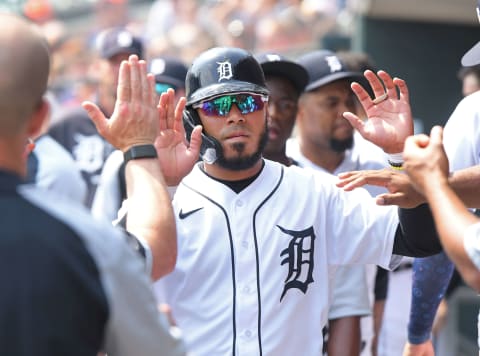
Detroit Tigers IF/OF Harold Castro
“Hittin’ Harold” Castro has been a fun story among the Detroit Tigers fanbase. He does seem to have a knack for finding those timely knocks to help the club win. In many ways, he’s an ‘old school’ baseball guy’s dream. He’s a guy that sprays the ball around, puts it in play, can play essentially any defensive position, and he does seem to have that ‘clutch’ factor.
Unfortunately, the ‘clutch’ gene has largely been debunked, his batting average is mostly empty, and while he can move around the diamond, he’s not particularly proficient anywhere, which is largely the value of those bench bats.
The Case for the Detroit Tigers Keeping Harold Castro
Control is on Castro’s side, but he’ll be out of option years after this season, according to MLive. He’ll get the MLB minimum in 2022 before becoming arbitration-eligible in 2023 and will be under team control through his age-31 season. That type of cost-certainty and control (assuming nothing changes with the next CBA) is valuable to an organization that is trying to build a sustainable winner.
Referenced above, Castro also plays basically everywhere, and AJ Hinch does value guys that can move around for him. As we discussed, though, that value decreases as there are more everyday guys on the roster who can move around as necessary.
The Case for the Detroit Tigers Moving On From Harold Castro
As referenced above, although Harold does rack up hits, he’s slugging just .348 and has eight home runs across his 689 career ABs. Those who cannot consistently hit for extra bases are more likely to have good fortune in terms of batting average and may be due for regression, backed up by his low barrel percentage (despite fairly average overall exit velocity metrics).
He also doesn’t walk much–a 3.8% clip across his career, according to Savant. While I do feel that hits are indeed more valuable than walks (runners can take extra bases on hits, etc), walking tends to be more sustainable and the on-base craze has put a premium on walks. His strikeout rate across his career is fine thanks to his innate bat-to-ball skills, but he absolutely has to walk more for his offensive profile to warrant any type of regular role.
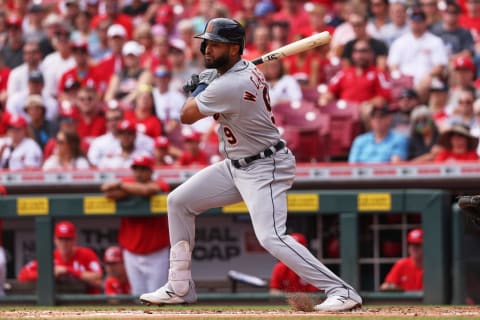
Detroit Tigers IF/OF Willi Castro
An infielder/outfielder that’s a switch-hitter with some pop sounds tantalizing, which is exactly what Willi Castro is. Unfortunately, his defensive struggles coupled with inconsistencies with quality of contact have his future outlook a far cry from that impressive .349/.381/.550 performance in the shortened 2020 rookie campaign.
Feels like a decade ago that Castro was the starting shortstop on Opening Day, but those days are likely over with his current .211/.268/.347 line and 18th percentile Outs Above Average metric. Nevertheless, the organization is giving him a shot at a utility spot, with seven games in left field after zero professional games in the outfield.
The Case for the Detroit Tigers Keeping Willi Castro
Like Harold, Willi is under contract through the 2026 season and would be a less expensive option than some of the more seasoned free agent options on the open market. Willi though does have an option year left in 2022, and that type of roster flexibility may be valuable to the organization, even if it doesn’t mean Castro would break camp with the MLB club next season.
An offseason of work in the outfield could do Castro some good as well as he prepares to battle for a spot. His limited numbers aren’t pretty in the grass, but his impressive sprint speed and fine athleticism suggest some improvement is possible with continued professional instruction. The question becomes whether or not his offensive output will justify a defensive spot where so many sluggers call home in the corner outfield.
The Case for the Detroit Tigers Letting Willi Castro Go
Since the Detroit Tigers can keep Castro in the minors next year, sending Willi Castro off doesn’t make a ton of sense. At the same time, his spot on the active roster in 2022 could conceivably be an uphill climb depending on the offseason moves.
Unfortunately, Castro doesn’t barrel the ball nearly consistently enough (5th percentile in barrel percentage) and his defense is already mentioned as some of the worst in the league as well. That combination usually isn’t a recipe for any roster spot, let alone a utility player. Bench players often have a calling card–maybe they can handle the bat but not play defense or vice versa. In Castro’s case, he hasn’t shown he has much to hang his hat on, which could mean his time on the MLB roster is running out.
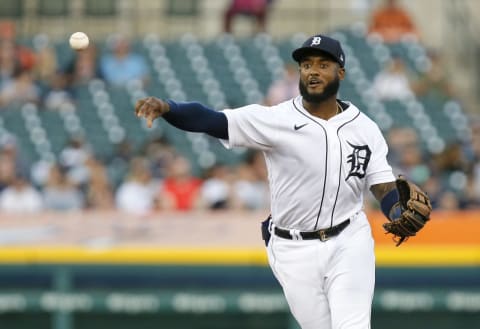
Detroit Tigers IF/OF Niko Goodrum
Hard to believe that Niko Goodrum is working through his fourth season with the Detroit Tigers as the club’s swiss army knife, but after 2.4 bWAR across 2018 and 2019, Goodrum hasn’t been the same player as a combination of regression and injuries have hindered his overall output across the last two seasons.
The Detroit Tigers have to decide, assuming roster improvements are made, whether Goodrum’s experience would be favored over some more affordable and younger routes.
The Case for the Detroit Tigers Keeping Niko Goodrum
Goodrum has experience on his side and 2021 is the first year that Goodrum has been below replacement level, according to Baseball-Reference. Some of his peripheral metrics would suggest this may be the anomaly rather than a trend downward. His Outs Above Average ranks in the 90th percentile and his sprint speed remains in the 84th percentile across baseball.
Likewise, although a switch-hitter, Goodrum’s numbers are exponentially better against left-handed batters (.260/.341/.325 vs .190/.273/.331), which may present an opportunity for him to either hit right-handed exclusively or be a platoon partner for a different left-handed bat that struggles against same-sided pitching.
The Case for the Detroit Tigers moving on from Niko Goodrum
Unlike the first couple of players, Goodrum doesn’t hold the affordability or control of Harold or Willi Castro. According to Spotrac, Goodrum has arbitration years in 2022 and 2023 before hitting the open market for 2024 and is nearing the other side of 30 years of age.
Additionally, it is fair to question if Goodrum’s strikeout numbers are too high to overcome. This is the second straight season where his strikeout rate is north of 30 percent, and if it weren’t for his solid walk rate (around 10 percent the last two years), this type of swing-and-miss would be tough to retain.
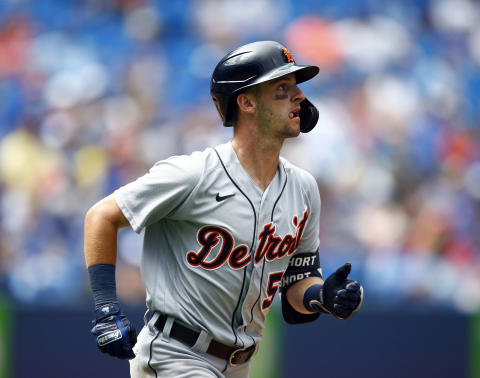
Detroit Tigers IF/OF Zack Short
Zack Short appears to be another candidate for a utilityman in 2022, as the organization has put him in the outfield at Triple-A Toledo in three games in addition to his usual second base/third base/shortstop stables.
Short saw some time with the MLB club this season and figures to be in the equation to make the Detroit Tigers next spring, but it is fair to question if his bat will play enough to stay long-term.
The Case for Keeping Zack Short
As is the case with Willi Castro, Short has option years left, which essentially means his short-term future with the organization is all-but-cemented. If he does not make the club next year, he will head to Toledo once again to be ready for an injury or roster change. The question is whether Short will show enough to warrant that coveted utility spot on the Detroit Tigers.
Short has control on his side, with his rookie status still intact through 2021, which means there is still some potential for growth despite his age (26). Although the metrics aren’t in love with Zack Short’s shortstop play, he does appear to be fluid with soft hands and a strong arm.
The Case for Letting Zack Short Go
There really isn’t one in terms of his spot within the organization, but in terms of him being ‘the guy’ right out of spring, he may have a climb. Like Willi Castro, Zack Short is brand new to the outfield, and trying to learn a new position at the MLB level is less than ideal.
Likewise, Short has struggled with his strikeout numbers like Goodrum and is working on making some mechanics changes with his bat path to help yield more contact, and thus help to leverage his speed which is currently in the 83rd percentile in baseball.
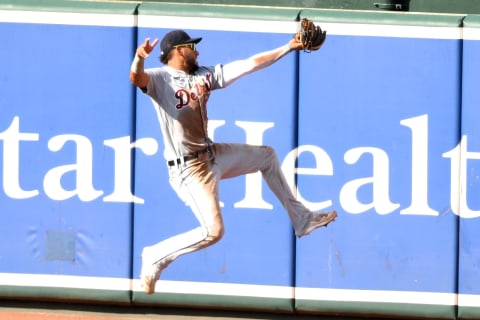
Detroit Tigers OF Victor Reyes
Divisive Rule 5 pick Victor Reyes was once one of the more controversial topics among the fanbase at one point, with arguments on both sides of whether Reyes was an everyday player or not.
Reyes is slightly above replacement level this year across his 67 games with a .246/.276/.415 line and slightly below-average defense in the outfield.
The Case for the Detroit Tigers Keeping Victor Reyes
Reyes is under contract through 2024 and has improved his exit velocity numbers compared to his first couple seasons; putting away the ‘soft serve’ nickname to an extent. As a switch-hitter, Reyes also offers the versatility in the box that some others may not have (splits are relatively similar).
Reyes also can play both corners, which would be helpful and likely more ideal than some of the newer competition for the spot when Grossman or Baddoo need a breather.
The Case for the Detroit Tigers Letting Victor Reyes Go
Replacement level guys are a dime-a-dozen and it’s fair to question if someone with more upside like Derek Hill or Daz Cameron would be a better fit for that role moving forward. Reyes likely is who he is–he can undoubtedly help an MLB club, but he’s shown he’s not the everyday guy some once thought.
Reyes as an exclusive outfielder may be a bit pigeon-holed compared to some others as well, which may limit his ability to find the lineup as consistent as some of the other players that can do both. Add to this that Riley Greene is very near being ready and it makes Reyes’ talents a smidge more expendable.